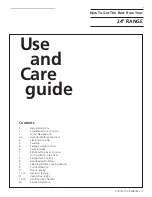
•
Do not use harsh or abrasive cleaning agents, rust removers, waxes, polishes, com-
mercial cooktop cleaners, steel wool, metal scrapers, or sharp objects to clean the
cooktop.
•
Always dry the surface completely with a lint-free kitchen towel to prevent limes-
cale deposits.
•
Never use a steam cleaner to clean this cooktop. Pressurized steam could cause
permanent damage to the surface and to components.
•
Keep the igniter in the burner base dry. If it gets wet, it will not spark.
PORCELAIN OVEN INTERIOR
Porcelain is made from natural materials and, therefore, can chip or develop fine lines
and cracks due to the expansion and contraction that occurs as the oven tempera-
ture fluctuates. This can result in cosmetic imperfections, such as a cloudy, dull, or
scratched appearance.
•
For best results, wipe up spills and splatters (especially sugary, acidic, and toma-
to-based sauces) as soon as the range has cooled to avoid staining of the surface. If
spills are allowed to cook on the surface, they may permanently stain. Never wipe up
a hot porcelain surface with a damp sponge. It may cause chipping or hair line
cracks.
•
Do not use harsh or abrasive cleaning agents, rust removers, waxes, polishes, steel
wool, metal scrapers, or sharp objects to clean the oven interior.
•
Wash the entire oven cavity with mild liquid dish soap and warm water.
•
Blemishes that remain should not affect the function of the porcelain.
•
Note: For easier cleaning, the bottom oven panel is removable by simply lifting up
when cool.
IMPORTANT: Do not clean the oven gasket. The fiberglass material cannot withstand
abrasion and rubbing and moving the gasket may compromise the door seal.
OVEN DOOR
•
Clean with a solution of mild liquid dish soap and warm water and a damp sponge.
Rinse well.
•
Do not allow excess water to run into any holes or slots in the door, including
around the glass frame. Any soap left on the liner causes additional stains when the
oven is heated.
•
Do not use oven cleaners, cleansing powders of harsh abrasives on the external
side of the door.
•
You may use a glass cleaner to clean the glass on the oven door to remove finger
-
prints or smears. Dry completely with a soft, lint-free cloth.
OVEN RACKS AND RACK GUIDES
•
Remove the Oven Racks from the oven by sliding out. The Oven Rack Guides can
be unscrewed for thorough cleaning.
•
Clean with a solution of detergent and hot water. To clean heavy soil, use a scouring
pad such as steel wool with plenty of water and a mild abrasive such as a paste of
baking soda and water or oven dedicated cleaning products.
•
Dishwasher Safe.
CONTROL PANEL, BURNER KNOBS, DOOR HANDLE
•
Clean with a solution of mild liquid dish soap and warm water and a damp cloth.
Wipe in the direction of the grain.
•
Do not use abrasive cleaners or scrubbers; they will permanently damage the finish
and printed surfaces.
•
Do not use any cleaning product containing chlorine bleach.
•
Dry the components with a soft, lint-free cloth.
TOP VENT
•
The stainless-steel top vent can be removed by unscrewing.
•
Use a non-abrasive stainless-steel cleaner to spray on any grease build up on the
underside of the vent. Leave to penetrate.
•
Wash with hot water and a mild dish soap.
•
Thoroughly dry before reattaching.
STAINLESS-STEEL BODY
•
Use a non-abrasive stainless-steel cleaner and apply with a soft lint-free cloth.
•
To bring out the natural luster, lightly wipe the surface with a water-dampened
microfiber cloth followed by a dry polishing chamois. Always follow the grain of the
stainless steel.
REPLACING AN OVEN LIGHT
•
Turn off the power at the main power supply.
•
To prevent electrical shock or personal injury, make sure the oven and light bulb are
cool and power to the oven has been turned off before replacing the light bulb.
•
Remove the lens cover from the housing by pulling straight out then replace with a
25W appliance bulb.
•
Make sure the lens cover is in place prior to using the oven again.
30





































